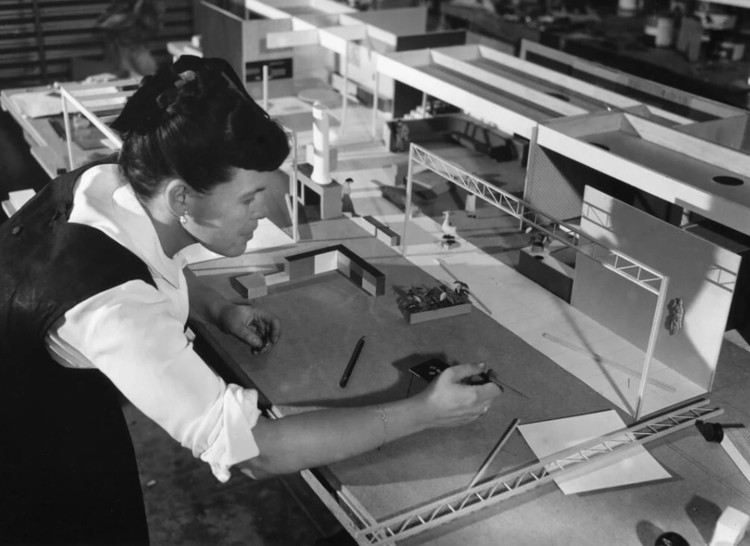
On the heels of the Eames Office’s 80th anniversary marked by an exhibition and a Ray-inspired sneaker, director Eames Demetrios spoke to Metropolis about the matriarch who continues to inspire design.

Metropolis: The Eames Office is 80 years old! How does that milestone inform new partnerships like one with Reebok?
Eames Demetrios: Milestones are always interesting. They’re a chance to reflect. Our mission is communicating, preserving, and extending Charles’ and Ray’s work, so we’re definitely anchored in that. But it’s not too limiting because of the breadth of the ways they approached the world. They also, I think, were very clear that they wanted the Office to keep going. I think they had a feeling—and I’m sure Ray did—that in order to really keep going, new things had to be done.
Metropolis: What’s the Eames Office’s role in new ventures?
Eames Demetrios: What [Charles and Ray] wanted us to do was to be part of the process with manufacturers and represent the designer in the equation, you might say, and to make sure the designs are made well, because it’s a process.
We have to make sure that in spite of all the hands that touch [a product], the customer has the experience Charles and Ray intended.
The Reebok partnership fits in because… Charles and Ray said, take your pleasure seriously. And I think one of the things they were good at is understanding that aesthetics can be a part of function. I think there are some people who are just going to think they’re cool-looking, and then maybe get turned on to Charles’ and Ray’s [historic] work.
Metropolis: Right, the shoe released this month has Ray’s artwork on it. Why does now seem, if you can forgive me putting it plainly, like Ray’s moment in the sun?
Eames Demetrios: There are not thousands of Ray paintings, but there are a number and it just seemed like this one [Composition] made just before she met Charles, would work well in the shoe. Again, what I like is that you don’t necessarily need to know who they were to enjoy these things. A lot of people entered [the Eameses’ designs] through the door of furniture. I think a lot of people are now going to enter through these sneakers.
Metropolis: Wow. Is the art on view in a permanent collection somewhere?
Eames Demetrios: It’s in the Columbus Museum in Columbus, Georgia, where it’s part of the rotating collection. It’s a real gem.


Metropolis: It’s always exciting to hear stories of women making an impact in design, especially during periods when there were fewer being recognized.
Eames Demetrios: Yes. You have to remember, at the time they got married in June of 1941, the world was not an upbeat place, even though America was not yet at war.
I say that because our mother remembered talking with the Saarinens about the war in Finland. Then, the Soviet Union had already attacked Finland at the same time as Hitler attacked Poland. So, [war] was in the air. And then, when World War II happened, and everything became accelerated especially Charles and Ray started getting involved in the war effort by making the splints.
Imagine that these two people come to Los Angeles for the purpose of starting a new life and exploring these ideas of design. They get an apartment, start doing experiments in plywood in their apartment, and they become a team pretty quickly. Even though Charles got a lot more credit in their lifetimes, he was always very clear that they were a team.
They both had a capacity for art. They both had a capacity for technology, and to separate them too much, I think is unwise.


Metropolis: Right, you say there were times when even with a staff, they’d often meet apart from everyone else to make decisions as a couple.
Eames Demetrios: Yes, I talked to some folks later and they were surprised that certain meetings had happened between just the two of them. As Ray said, ‘At the beginning, you don’t want to waste other people’s time. You need the time to make mistakes. You need the time to figure things out. And then, you bring people in.’ That was what Charles and Ray did together.

I think it’s important for people to realize that you can co-create. You can work, and each bring your best selves to the process.
Metropolis: There’s also a real romance that I think you’re sharing by highlighting Ray.
Eames Demetrios: A friend of mine told me that he was with Ray and she talked about the moment in the forties when she and Charles would walk down to Westwood and look longingly at the tools for sale in the Sears Roebuck window, which is so romantic.
Metropolis: How did that romance allow them to exercise a sense of wonder?

Eames Demetrios: They really stayed true to that path of focusing on the things where they can make a contribution, not getting distracted. And then they made this very self-reliant environment in the Office [where they] had a black and white photo lab, a color photo lab, a place to edit, a significant library, a workshop, a kitchen. They could get through all these different steps, including 3D printing.
Metropolis: Sounds like they enjoyed some seclusion.
Demetrios: To your point, one of the reasons they moved to Los Angeles was they didn’t know anybody there. They were consciously avoiding too many distractions.
This article was originally published in Metropolis.















